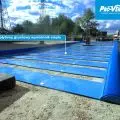Work submitted for the competition
"Best Diploma Architecture"
Always in a hurry, trying to keep up with the pace of everyday life, it is easy to lose touch with ourselves. In today's world, we lack moments to consciously listen to our own needs. Modern society is immersed in a sense of disorientation in the face of an overabundance of stimuli. In the midst of the hustle and bustle, we have to constantly make decisions, assimilate a lot of new information, and above all — constantly rush forward.
The engineering design of the Marina of the People of the Road is a proposal for an architectural premise in the spirit of slow tourism. The main idea is to pay attention to traditional ways of travelling, such as hiking, during which travellers can experience a moment of peace, experience the traversed landscapes and re-find themselves in the surrounding space.
site plan
© Agnieszka Wiecha
Slow hiking allows one to discover local natural and cultural heritage, and establish a deep individual bond with it. The effect of the continuity of passing views builds a sense of belonging.
The diploma focuses on the design of a hostel with a chapel along the Way of St. James in Jura Krakowsko-Czestochowska. It is intended to be a space of contemplation and rest for pilgrims following the Camino de Santiago route, leading to Santiago de Compostela in Spain. The location of the complex has been adapted to the existing route of the trail between Krakow and Olkusz, where this type of tourist infrastructure is lacking.
Przystań Ludzi Drogi
© Agnieszka Wiecha
Located on the edge of the Ojcow National Park, the complex consists of two buildings. The architecture of the buildings is designed to create a coherent narrative whole, reflecting the rhythm of the pilgrim's route. The hostel serves as a safe haven where weary travellers can find solace at the end of the first day's trek, while the chapel marks the beginning of the next stage of the journey. The complex has been placed along the Way and subordinates the design to it.
A hostel along the Way of St. James in Jura Krakowsko-Czestochowska
© Agnieszka Wiecha
On the right the hostel, on the left, in the distance — the chapel
© Agnieszka Wiecha
The facilities have been arranged in such a way as to interfere as little as possible with the existing landscape, hence the decision to locate each of them in the surroundings of existing buildings. Pilgrims entering the plot are greeted by a hostel, which offers them hospitality. A chapel can be seen in the distance, heralding the next day's trek, which began with sunrise.
model of the hostel
© Agnieszka Wiecha
The shelter's building is based on a wooden structure surrounding a shaft made with rammed earth technology. An identical use of this material can also be found in the design of the chapel. The central core of the shelter concentrates the most important activities of hikers, while accumulating heat. The kitchen and hearth room build a cozy atmosphere, emphasized by the soft light seeping through the skylight at the top. The corridors circling the core offer a meeting place with windows overlooking the valley. The upper floor, serving as the sleeping quarters, was overhung above the terrace, offering a spacious porch with sunset views and a chapel.
chalet, sections
© Agnieszka Wiecha
The central core of the shelter made of compacted earth
© Agnieszka Wiecha
The chapel was designed as a walk-through building, using a simple form to draw pilgrims' attention to the essence of the trek. The rammed earth walls were raised on wooden logs reinforcing a skylight placed at the very floor. The light cast on the feet of the hikers, combined with the twilight of the vault, allows for a unique visual and impression effect.
section and projection of the chapel
© Agnieszka Wiecha
The design of the complex is rooted in the philosophy of vernacular architecture, emphasized by the use of local materials and typological consistency. Great attention was paid to matching the architecture with the natural context, respecting the unique location.
The design of the chalet pays homage to the Swiss-Father style, derived from the region's spa tradition. The modest form of the chapel, meanwhile, tries not to compete for attention with the imposing landscape. The architecture of the buildings is a spatial reflection of the concept of the sacred and the profane.
Agnieszka WIECHA
Illustrations: © Author















































